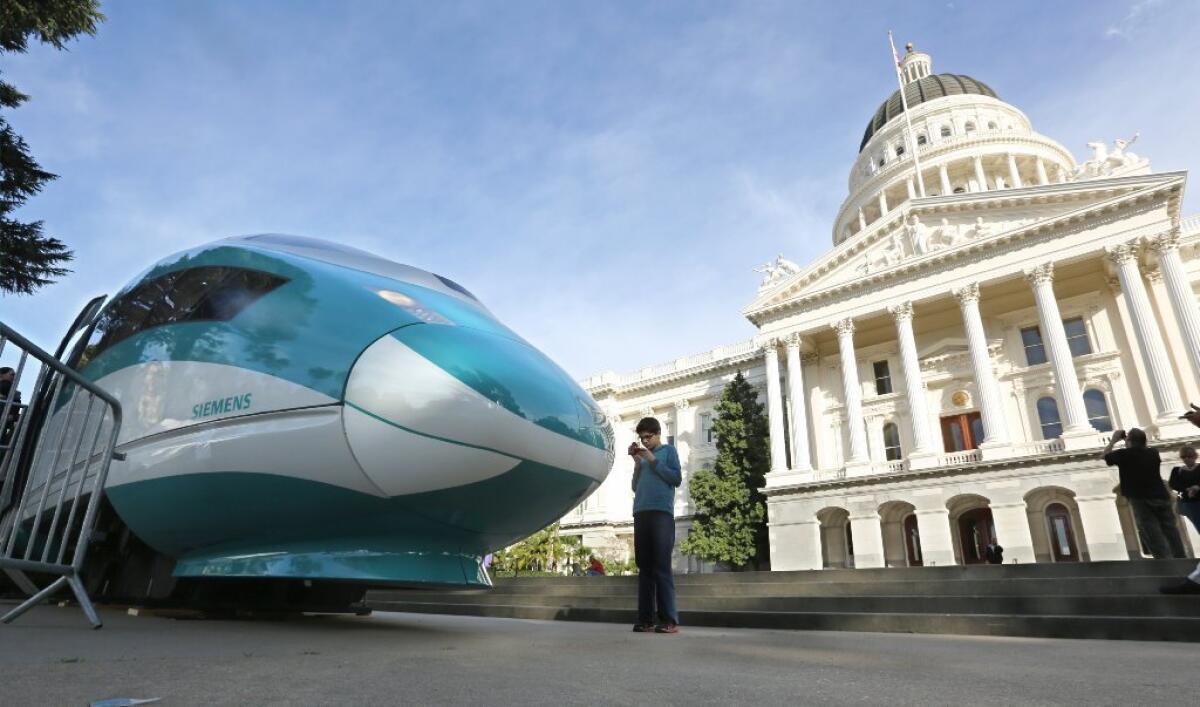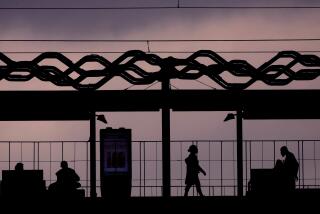Bullet train: Failure to identify funding for Southern California leg unacceptable, official says

A full-scale mockup of a high-speed train is displayed at the Capitol in Sacramento in February 2015.
The California rail authority’s failure to identify a source of funding to connect Los Angeles to the future bullet train system is not acceptable, said Hasan Ikhrata, executive director of the Southern California Assn. of Governments.
Until the high-speed rail authority released a new draft business plan last month, the state had planned to open its first operating segment between Burbank and the Central Valley by 2022. But in a major concession to its limited funding, the plan now calls for a cheaper segment that would run from San Jose to the Central Valley by 2025.
By the time that initial segment is built, all the existing funds would be exhausted, leaving uncertainty about how and when the line would cross the geologically complex mountains of Southern California.
The lack of specificity is stirring some deep concerns among legislative analysts and Southern California’s political leadership, reflected in Ikhrata’s position. Ikhrata is scheduled to testify at an Assembly oversight hearing on Monday and says he will deliver a message that there are still too many unknowns in the plan.
“You can’t say you can do something without saying how you are going to pay for it,” he said in an interview. “This is a must. If you don’t have the money in the bank, I understand that. But you can’t assume the money is going to fall from the sky. You have to have a path. You can’t be silent totally.”
The state’s Legislative Analyst’s Office has raised the same concerns, saying in a report that the business plan fails to make a case for how it will pay for a completed system. The bullet train has been funded so far by a $9-billion bond, $3.2 billion in federal grants and about $500 million a year in greenhouse gas fees, all of which leave big shortfalls in the $64-billion megaproject. The shortfall is estimated at $43.5 billion, an amount that would be difficult or impossible to find in the short term.
The Assn. of Governments has played a key role in representing the region at the rail authority, signing a 2013 memorandum of understanding that provided for about $1 billion of investments in Southern California’s transit systems to prepare for the future bullet train. The deal put Southern California on a near equal footing with the Bay Area, which received money to electrify its Caltrain commuter system.
See more of our top stories on Facebook >>
But the larger questions remain about the project’s ability to deliver a system that would connect Los Angeles and San Francisco in two hours and 40 minutes, which is required under the 2008 bond act that voters approved. In the earlier plan, the rationale for starting Southern California was based on the region’s larger population and the gap in passenger rail service that now exists between Bakersfield and Palmdale over the Tehachapi Mountains.
Rail authority chief Dan Richard said in a recent interview that closing the rail gap remains important, but the state simply did not have the estimated $31 billion it would take to build in the south. The northern alternative would cost $21 billion and allow the state to build an operating system, theoretically with the funding it already has.
“We understand that high-speed rail wants to start in the north,” Ikhrata said. “We understand that logic. Having said that, this system will only be valuable if this connects San Francisco to Los Angeles.”
The statement reflects a continued belief that starting the system in the south remains the most logical approach and some nervousness that the region could be left behind, despite Richard’s often-repeated assurances that “nobody will be left behind.”
“The most important segment is from Bakersfield to Palmdale because there isn’t any rail connection,” Ikhrata said. “That gap must be closed and the business plan must be clear how they are going to close it. If they build a system that fails to connect Los Angeles, this will be the biggest failure of an infrastructure project we have ever had in the state of California. It will be sad for future generations.”
A central political reality of the bullet train project is that its main supporters are from Northern California, led by Gov. Jerry Brown. Ikhrata said the project does not have enough support among the key leaders in the Los Angeles region.
“You don’t find advocates because the story has changed so many times,” he said. “They are getting antsy. They are playing along.”
There also remains critical questions about how the future bullet train system will actually be constructed and how it will operate in Southern California, which Ikhrata believes needs to be addressed sooner rather than later.
“We are still where we started,” he said,
Ikhrata said the business plan now envisions using shared track through much of Southern California, though exactly what that means is unclear. In earlier planning, the state rail authority had planned to share track with Metrolink commuter trains and freight trains between Los Angeles and Anaheim. In the prior plan, the system would have had dedicated exclusive track between Los Angeles’ Union Station and Palmdale.
But Ikhrata said the blended system would now include the section between Union Station and Palmdale.
If so, it could affect the top speeds of the trains. Under past plans, the rail authority said the trains would operate at the full 220 mph between Bakersfield and Los Angeles. But a blended system could result in lower planned speeds, as it has in the Bay Area.
ALSO
State revises proposed bullet train routes, but San Fernando Valley communities remain skeptical
‘It’s not supposed to be this way’: Why it’s getting more difficult for foster families
Here’s what $100 million in renovations will let the Seal Beach Naval Weapons Station do
More to Read
Sign up for Essential California
The most important California stories and recommendations in your inbox every morning.
You may occasionally receive promotional content from the Los Angeles Times.











